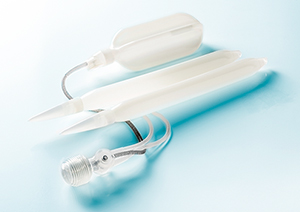
What is an Inflatable Penile Prosthesis?
An inflatable penile prosthesis is an implant that replaces the normal erectile function of the penis. Simply put, it is a device that allows you to have a natural feeling erection on demand. Men with erectile dysfunction that doesn’t respond well to other therapies, or who have side effects from other therapies can consider this procedure as a permanent solution to weak or absent erections.
Why might I need an Inflatable Penile Prosthesis?
Any man with significant erectile dysfunction (inability to maintain an erection sufficient for satisfactory sexual activity) can consider placement of an inflatable penile prosthesis. This surgical procedure is most commonly used for men who had tried other therapies to help erections, such as Viagra or Trimix, but have not had satisfactory results.
Men with Peyronie’s disease, a curvature of the penis that occurs due to scar tissue formation, can also consider this procedure. For men who have both erectile dysfunction and Peyronie’s disease, inflatable penile prosthesis placement can be a highly effective treatment for both conditions.
Special consideration for men with diabetes
Many men with diabetes have erectile dysfunction. This is due to the damage elevated blood sugar does to the nerves and tiny blood vessels required for a quality erection. Men with diabetes who are considering placement of an inflatable penile prosthesis must have a Hemoglobin A1c score of less than 8% to safely undergo this surgery. Keeping your diabetes under control is always good for your health and is essential to have a safe surgery.
Preparing for your Inflatable Penile Prosthesis:
In general, preparation for an Inflatable Penile Prosthesis will involve the following steps:
- You will have bloodwork and other testing done at the hospital
- The hospital will call you to confirm arrival time and instructions
- You will be asked if you have allergies to medications, anesthesia, or latex.
- You should inform your doctor of any medications, vitamins, or supplements that you are taking.
- You should refrain from taking anti-inflammatories or blood-thinning medications a week prior to the procedure. Any blood thinning medications will be discussed with you and your doctors
- You may be asked to refrain from eating 8 hours prior to your scheduled arrival time and drinking 2 hours prior to your arrival time.
- You should remove all metal objects and accessories such as eyeglasses, jewelry, watch, etc. as they can interfere with the imaging technique used.
- You should arrange for someone to drive you home after the procedure.
What happens during placement of an Inflatable Penile Prosthesis?
Prior to the procedure an anesthesiologist will discuss the options for anesthesia with you. Most men have general anesthesia, in which they are completely unconscious, but a small portion of men will choose to have spinal anesthesia.
Once you are in the operating room the anesthesiologist will give you medication to make you go to sleep. The hair on your genitals (if any) will be clipped and your genitals will be cleaned with a sterilizing solution.
Most men will have a pudendal nerve block placed. This is a type of local anesthesia that causes numbness of the genitals and inner thighs. This lasts for around 12 hours after the procedure and has been shown to greatly increase your comfort. A urinary catheter will also be placed during the surgery but is removed before you wake up.
To place the prosthesis, a single incision will be made in your scrotum. The cylinders of the prosthesis are placed into the penis, followed by a reservoir of saline that is placed in the lower part of your abdomen. Finally, a pump unit is placed into your scrotum and the incision is closed. A supportive dressing is placed and your prosthesis is left partially inflated.
You will wake up in the recovery room after your procedure.
Post-Operative Instructions
Medications:
You will be given pain medication to help control any discomfort you feel after your surgery. Usually this will include regular doses of Tylenol, with the addition of opiate-based analgesics as needed. Your surgeon will review your medical history and instruct you what you will be prescribed.
You will be prescribed laxatives to reduce your risk of constipation. If you find these are making your stool too loose, you should stop them.
You will be given a course of antibiotics. It is very important to complete this course of antibiotics.
Bathing:
Do not bathe for 3 days after your procedure. You can use wet clothes to wash your body, but don’t allow your incision or dressing to get wet.
Wound Care:
You can remove the dressing on your genitals 48 hours after your procedure. Sometimes the dressing will fall off earlier than this.
Activity:
You cannot use your prosthesis until instructed by your surgeon. You can walk, carry up to 10lbs, and eat normally after your surgery. You should not engage in strenuous activity, heavy lifting, sex, or masturbation until you are told it is safe.
Follow up:
Most patients will see their surgeon 2 and 6 weeks after their surgery. At the two-week visit you will be taught how to use the device and the surgeon will inspect your incisions. At the six-week visit your surgeon will review your progress. Most patients are able to resume sexual activity six weeks after their surgery.
What can I expect after my Inflatable Penile Prosthesis?
Immediately following your surgery it is normal to have significant bruising and swelling of your genitals. This can be alarming, but is normal. It is not normal to have progressively increasing swelling, leakage of blood from your incisions, or to have your scrotum significantly increased in size. If you have any concerns, call your surgeon’s office.
Expect it will take around 6 weeks to heal before you can use the penile prosthesis.
What are the risk of an Inflatable Penile Prosthesis?
The most significant risks of penile prosthesis placement are infection of the prosthesis and erosion of the prosthesis through surrounding tissue. These are uncommon, occurring approximately 1% and 0.5% of the time respectively. The prosthesis is a foreign object and if it becomes infected, usually needs to be replaced. Thankfully this is a rare complication.
Bleeding, causing a hematoma (localized blood clot) is also a risk of this procedure.
Other risks include injury of local structures such as nerves, blood vessels, and the urethra. Other risks are exceedingly are and your surgeon can discuss them with you.
